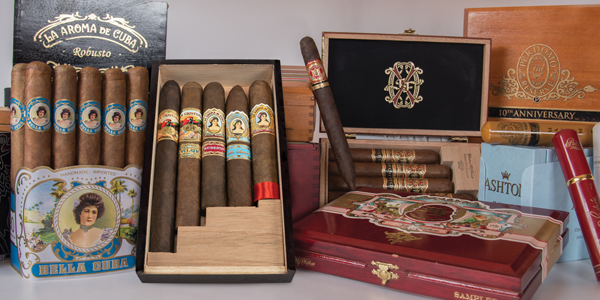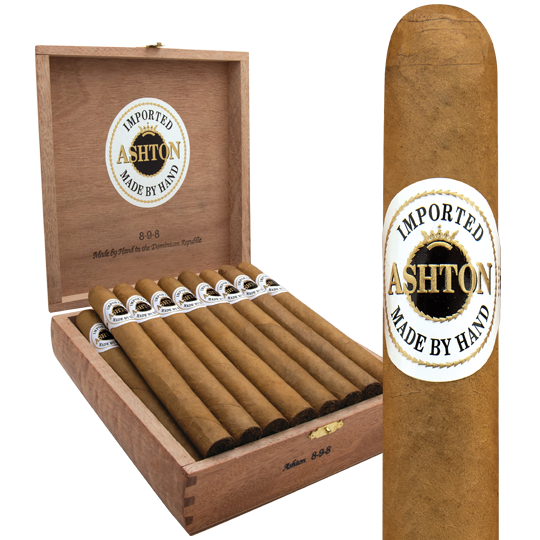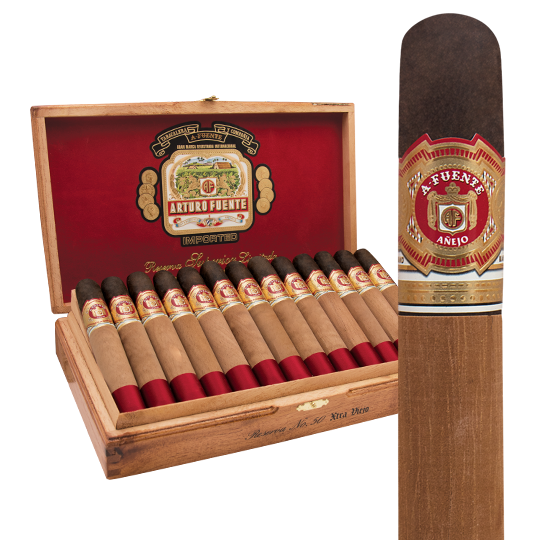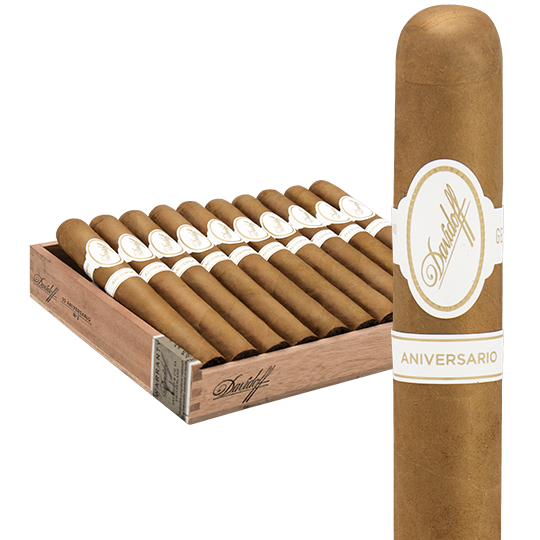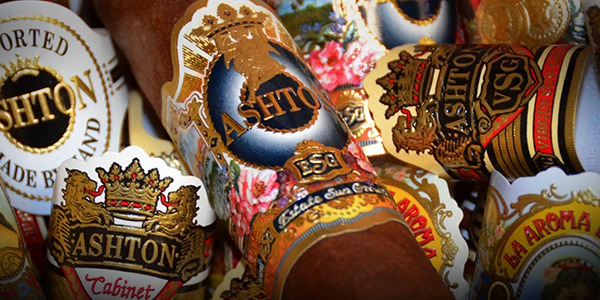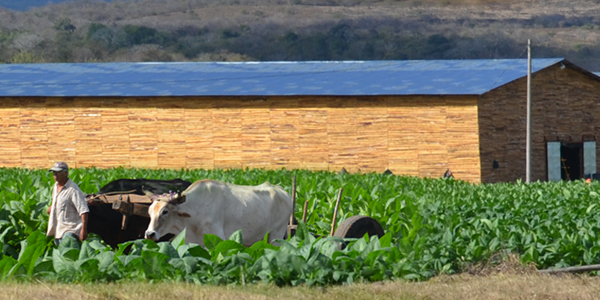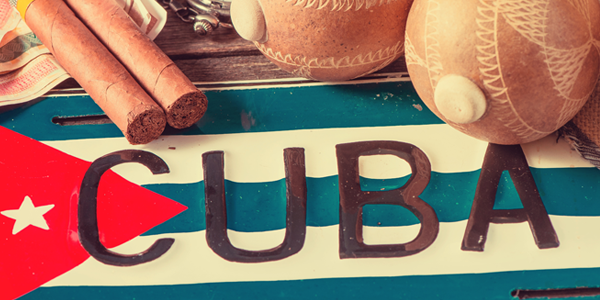10 Things to Know About Cigar Boxes and Bundles
Okay, here’s a fun fact to consider that actually will make you love cellophane. Back in the day, Cuban cigars for export, believe it or not, were bundled and covered with the bladders of pigs. Oh sure, the packagers put some vanilla in there to cover the porcine smell, but, well, you know. That delightful form of wrapping gave way to an alternative approach: packaging large numbers of cigars, around 10,000 or so, into large wooden chests. Yeah, like pirate treasure. Not exactly easy to carry around.
The Box
Fortunately, in 1830, before the company got into the cigar business, H. Upmann was a bank that began sending cigars sealed in cedar boxes to its staff in England. The bank would put its logo on the boxes and it was discovered that the cedar actually helped keep the cigars from drying out and wicks away excess moisture. It also keeps cigar beetles away. Nature!
Boxes also make it easy to promote branding and to appeal to the eye of the buyer. Cedar continues to be used, sometimes as a single sheet covering the cigars in a box, sometimes as a sleeve that is wrapped around each individual cigar, like the Arturo Fuente Añejo and Don Carlos Edición de Aniversario, among others. The cedar, once you’ve removed it, can serve as an aromatic match – called a ‘spill’ -- to light the cigar. Just be sure to get rid of any tape or ribbon on the cedar before setting it ablaze. Try the Ashton Double Magnum and see if you can detect the nuances in flavor the cedar sleeve contributes.
Today, most premium cigars, like the Ashton brand, come in wooden boxes, made of relatively affordable cedar plywood and most made at the factory of the cigar-maker. Boxes made entirely of cedar came along around 1900 and were referred to as boite nature, or natural packing in French. The initials ‘BN’ are also used. BN boxes are made using a method called ‘lockwork,’ which utilizes machine-cut interlocked corners (sometimes mistakenly referred to as ‘dovetailing’). The corners are then glued together, not nailed shut.
More expensive cigars are the ones that get placed in solid cedar or mahogany. The Fuente Fuente Opus X comes in mahogany. The machines Fuente uses to make boxes for uniquely shaped cigars, like the Hemingway Masterpiece for example, are very expensive and can craft works of art in their own right. Early versions of the cigar box utilized strings that were held in place by wax to clasp the box lid shut. Storing cigars in their original box, no matter how pretty, is not recommended, unless you’re placing the entire box in a humidor. The original box will protect the cigars but won’t keep them properly humidified.
A less artistic, but very practical box, is the five-pack. Sometimes it’s a four-pack and other times there are six cigars. This is a box usually made of cardboard that is fully branded. It’s an easy way to carry a few cigars and keep them protected. It’s also a convenient opportunity to get your favorite cigar lover a gift of his or her favorite brand without having to purchase a whole box. Ashton, Padrón, and Davidoff cigars are available in this type of packaging. The Padrón 1926 series comes in boxes of four. The Padrón 1964 Anniversary Principe, to name one, comes in packs of five. Davidoff gift packs come in boxes of three to five cigars. Give a gift pack a try when you want to experiment with a brand, but you’re not prepared to buy a full 20 or 25-count box.
Samplers
Samplers are almost required these days to market cigar brands. I love samplers. They make great gifts and afford me the opportunity to try different cigars and really make comparisons. Think of them as ‘cigar flights.’ My favorites are brand samplers, where each cigar is from the same maker and you can get a real sense of the differences among them. I think two of the best going right now are: the Ashton 5-Cigar Assortment, in which you get five Dominican-made cigars including the Ashton VSG Robusto, Ashton Heritage Churchill, Ashton Cabinet Pyramid, Ashton 8-9-8 and the Ashton Aged Maduro #40; and the Ashton VSG assortment of five different shapes. The Oliva 8-Cigar Assortment comes in a beautiful box, each cigar in its own appropriately-sized cutout bed. It’s always a top-seller.
Bundles
Bundles are a sort of no-package packaging, of anywhere from 10 to 50 cigars. Bundles have been around for decades and are still very popular today. Because the cost of a box is not factored into the price, the cigars can typically be sold for less. While bundled cigars are not always considered top-of-the-line smokes, quality and value are emphasized. Bundles are great when you need a lot of cigars for a big group of casual smokers. A number of our best customers, including many seasoned connoisseurs, are bundle fanatics.
I’ve recommended Flor de Oliva Corojo to friends who play a lot of golf. The cigar is crafted from Nicaraguan long-filler made by the Oliva family, one of the best in the business, and is more than reasonably priced at what comes to about $2.50 per stick. The Quorum brand is another great Nicaraguan-crafted bundle beginning at around $1.50 per cigar and has been a favorite of Value Hounds for years. Bella Cuba regularly tops our sales charts and is handcrafted in the Dominican Republic to award-winning standards with introductory prices below 90-cents per cigar.
When bargain prices and big-name brands trigger your fancy, it’s tough to beat Rock Patel’s illustrious, golf-themed Mulligans franchise. Here, you’ll find a large selection of Rocky Patel bundles that the cigar-maker produces to test out new cigars and experimental side projects. Rocky Patel Mulligans cigars have exploded into a virtual cottage industry for Rocky fans who love to taste all the great new blends Rocky’s working on outside of his national ‘Luxury Collection.’ Plus, you’re guaranteed a generous everyday discount on every cigar in the Mulligans lineup because they’re packaged in cost-effective bundles instead of boxes. Rocky Patel Mulligans have been purchased by over a million customers and growing to date.
Cellophane
Cellophane is, without going into great detail, regenerated cellulose, which comes from plants. The value of cellophane to a cigar is protection. It’s much safer to carry a cigar in a cellophane sleeve than to put it unwrapped in your shirt pocket. Storing cigars in cellophane continues to be a topic of passionate debate. It’s a good thing, I maintain, to have the cigars in cellophane when they are on a shelf in a cigar store humidor. They are protected. Cellophane is permeable, meaning it can breathe and allow some moisture to enter. The wrapper leaf is better protected in most retail environments with cellophane. If you are taking home a box of cellophane-sleeved cigars, I recommend removing the cellophane so that the cigars are more directly exposed to the humidification in your humidor. A good practice is to keep a couple of empty cellophane sleeves (or a tube) around in case you want to take a cigar out on the town.
Tubes
Some cigars come packaged in tubes made of metal (aluminum) or plastic. Tubes, or tubos, provide excellent protection and are elegant carriers for, say, your Davidoff Aniversario Special R Tubo. Protection was the primary motivation for the adoption of the aluminum tube in the early 1930s by H. Upmann. The company’s owners wanted to sell more widely and to ensure that the quality and construction of the Havana cigar could be protected by sealing it in an aluminum tube. It was originally called the ‘Solo-Seel.’ Despite doubters, the sales of tubed cigars soared in the 12 months following their debut.
You’ll sometimes find the cigar inside the tube is also sleeved in cedar. Cigar tubes were sometimes made of glass, but the weight and fragility of glass tubes has made the practice less common. The idea of the tube is to keep the cigar fresher for a longer period after packaging, but don’t assume that a tubed cigar at the store hasn’t been opened. That’s why I like to take the cigars I’m storing in my humidor out of the tubes – or at least remove the top – so that they humidify properly. The Perdomo 10th Anniversary Champagne Magnum 50 Tubo is well worth a shot for the lover of medium-strength cigars.
10 Fun Facts About Cigar Packaging You Can Tell Your Pals at the Next Herf
1. Pig bladders were among the earliest packaging of cigars. Yuck!
2. H. Upmann created the cigar box.
3. Cedar is a natural repellent of the cigar beetle.
4. A piece of cedar used to light the cigar is called a ‘spill.’
5. Cigar boxes are usually made of cedar plywood or solid cedar or mahogany.
6. Most cigar manufacturers now make their own boxes at the factory using expensive machines.
7. Cigar boxes are made using a method called ‘lockwork,’ sometimes mistakenly referred to as ‘dovetailing.’
8. The earliest cigar ‘clasp’ was made of string that was tied and sealed with wax. Today, the clasp is usually made of metal.
9. The Ashton ‘8-9-8’ cigar is called that because of the way 25 cigars are packed into a box in three layers: eight on the bottom, nine in the middle, then eight on the top row.
10. Cellophane ‘breathes,’ allowing in moisture, and is also biodegradable.

